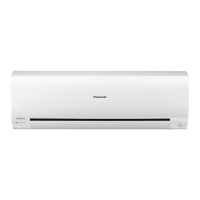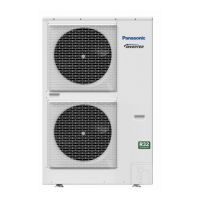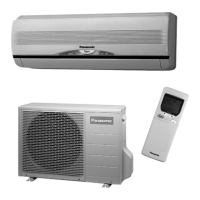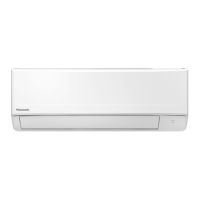1
1-11-27
Do not open the 3-way valve until the piping installation is completed.
• It is closed during shipment.
• During installation the side panel may warp if only the fl are nut is loosened and tightened with a torque wrench.
As a result, always be sure to secure to the hexagonal part of the 3-way valve with a spanner, or other tool.
Refer to the following table for the tightening torque of the 3-way valve fl are nuts.
• If the nuts are over tightened, they may cause the fl ares to break or leak.
Do not add additional force to the valve’s cover.
• Using spanners on the cover or valve itself (other than the hexagonal parts) may cause gas leakage.
Avoid using spanners on the cover or parts other than the hexagonal part of the valve.
Precautions when operating the 3-way valve for piping installation
• Use an Allen wrench (Size 4 mm or 6 mm).
Direction to open
[3-way valve operation method]
Opening : Open the cover and turn the Allen wrench counter-clockwise until it stops.
Closing : Open the cover and turn the Allen wrench clockwise until it stops.
Ensure not to scratch the inner surface of the valve or the end of the valve shaft.
• Once adjustments to the valve are completed, ensure to tighten the valve cap according to the prescribed torque.
Precautions for handling the valve cap
Tightening torque (approx.)
Valve cap
(Valve size)
ø9.52
(Liquid side)
20.6N•m~28.4N•m
(206
f•cm~284 f•cm)
ø15.88
(Gas side)
48.0N•m~59.8N•m
(480
f•cm~598 f•cm)
Service port
10.7N•m~14.7N•m
(107
f•cm~147 f•cm)
Use a push-rod with a charge hose.
• Once adjustments to the valve are completed, ensure to tighten the valve cap according to the prescribed torque.
Precautions for handling the service ports
For proper connection, align the union and fl are straight with each other.
Ensure that the pipes do not come into contact with the compressor’s bolts or exterior panel.
There is a risk of condensation from the 3-way valve coming out between the insulation material and the indoor unit’s
piping when you install the outdoor unit above then the indoor unit. Ensure to caulk the connection parts.
Precautions for connecting the pipes
Caulking treatment, etc.
Insulation
material
Piping
In high humidity environment, reinforce the insulation material for the refrigerant piping. Failure to do so may result in
condensation on the surface of the insulation material.
Use materials with good heat-resistant properties as the heat insulator for the pipes. Ensure to insulate both the gas side
and liquid side pipes.
If the pipes are not adequately insulated, condensation and water leakages may occur.
Ensure that the current insulation covers the pipes up to the unit’s connecting part.
If the piping is exposed, it may cause condensation or burn (when touch the pipe).
Precautions for insulation installation
Maximum temperature limit of gas or liquid piping exceeds 120 °C
Interconnecting refrigerant pipework, i.e. pipework external to the unitary components, should be marked
with a Class label (see right fi gure) every two metres where the pipework is visible.
Label size is 50 mm×50 mm.
This includes pipework located in a ceiling space or any void which a person may access for maintenance
or repair work within that space.
Class label
Dimensions when adding fl are nuts and the tightening torque
Precautions for flare nut installation
finoc eralFA snoisnemid noitces eralF).xorppa( euqrot gninethgiTezis gnipiP guration
ø 6.35
14.0 N•m~18.0 N•m
(140
f•cm~180 f•cm)
8.7 ~ 9.1 mm
90° ± 2°
45° ±1°
ø 9.52
34.0 N•m~42.0 N•m
(340
f•cm~420 f•cm)
12.8 ~ 13.2 mm
ø 12.7
49.0 N•m~55.0 N•m
(490 f•cm~550 f•cm)
16.2 ~ 16.6 mm
ø 15.88
68.0 N•m~82.0 N•m
(680
f•cm~820 f•cm)
19.3 ~ 19.7 mm
After piping connection has completed, ensure there is no gas leakage.
When tightening the fl are nut, coat the fl ares (inner surface only) with refrigerant oil on the fl ares
Firstly, screw in 3-4 turns by hand.
Ensure not to get oil on the screw part.
Refrigerant oil used is ether-based.
Once the piping connections are completed, perform leakage inspection using nitrogen gas.
When fl ared joints are reused, the fl are part shall be re-fabricated.
Application for ether-based oil
Service port
Service port
Hexagonal part
of the valve
Valve shaft
Valve shaft
Valve cap
Valve cap
Flare nut
Flare nut
Gas side
Liquid side
Spanner
(Secure)
Torque
wrench
Torque
wrench
(Please use a single, open-end spanner to loosen and
tighten the liquid side 3-way valve fl are nut.)
Ensure to do the re-fl aring of pipes before connecting to units to
avoid leaking.
To prevent the ingress of moisture into the joint which could have the potential
to freeze and then cause leakage, the joint must be sealed with suitable
silicone and insulation material. The joint should be sealed on both liquid
and gas side.
Insulation material and silicone sealant. Please ensure
there are no gaps where moisture can enter the joint.
Silicone Sealant must be neutral cure and ammonia free. Use of silicon containing
ammonia can lead to stress corrosion on the joint and cause leakage.
SM830266-00_大洋州向けR32シングルTD&SM.indb 27 18/03/29 10:20:15
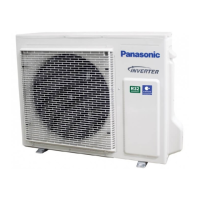
